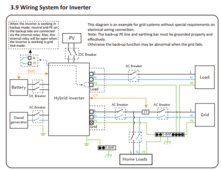kolek
Inventor of the Electron
- Joined
- Sep 29, 2021
- Messages
- 655
Sorry for this wall of text, I tried to keep this short but it's not easy.
There are other ways to handle electrical system grounding (aka earthing), and other countries do it differently from the United States.
France and Japan use a "TT" type electrical systems which:
- do not bond anything to any current carrying conductor at the service
- do not pose any serious risks in the case of a broken neutral
- should always have an RCD (GFCI) as its first isolator
See https://en.wikipedia.org/wiki/Earthing_system for more info about the TT electrical system.
My electrical panel:
- Has 3 wires, L1/L2/N, 3 phase 100/200VAC
- Does not have a neutral busbar
- Does not have a ground busbar
- Has no option to bond neutral to ground
- Has an RCD (GFCI) protecting all the house breakers
- Has neutral being switched on/off by the main breaker and the RCD
Current earth ground / neutral / bonding situation:
- No earth ground connected to the panel
- Only have an earth ground where the washing machine is located, but unclear if that is actually connected to earth
- No grounding wire or 3-prong plug at the outlets, with the exception of where the washing machine is located.
----
Doing research on others installing solar in Japan:
- Cannot find anyone discussing N-G bonding, whether that happens here, or if it's necessary here
Already spoken about this with others on the forum here in Japan, like @Daddy_Tanuki. And unfortunately the electricians in Japan are unfamiliar with DIY solar and aren't qualified to handle an install like this.
Unlike most U.S. solar installations, you can install small residential solar in Japan without permits or inspections.
Details about my system:
1 x DEYE SUN-8K-SG01LP1-US/EU, 8KW, 48VDC IN, 100/200VAC IN, 100/200V OUT
28 x LONGI SOLAR HALF-CUT LR4-72HPH-455M, (455W) MODULES
28 x (EVE) LiFePo4 BATTERIES, 3.2V, 280AH, JKBMS TOTAL 28.672kWh, 51.2VDC
My plan is to:
1. Install a RCD (GFCI) at the inverter input, and there is already another RCD installed at the output, so that all house circuits are protected by the RCD
2. Run a ground wire to the panel and connect that to inverter chassis ground as well as other metal cases in my install.
3. Run a ground wire from the PV panel frames to the inverter chassis. (better to connect PV frame ground to inverter rather than directly to grounding rod according to @Hedges)
I'm including a picture of my electrical panel.
But beyond those 3 things, anyone have any other suggestions? I'm particularly unclear about how to handle the N-G bond in a TT electrical network like Japan. Please do NOT comment if you have no knowledge of an electrical environment like this. Patronizing or hysterical comments like "GET HELP BEFORE YOU START A FIRE AND ELECTROCUTE YOURSELF" will be ignored.
Thanks guys!
There are other ways to handle electrical system grounding (aka earthing), and other countries do it differently from the United States.
France and Japan use a "TT" type electrical systems which:
- do not bond anything to any current carrying conductor at the service
- do not pose any serious risks in the case of a broken neutral
- should always have an RCD (GFCI) as its first isolator
See https://en.wikipedia.org/wiki/Earthing_system for more info about the TT electrical system.
My electrical panel:
- Has 3 wires, L1/L2/N, 3 phase 100/200VAC
- Does not have a neutral busbar
- Does not have a ground busbar
- Has no option to bond neutral to ground
- Has an RCD (GFCI) protecting all the house breakers
- Has neutral being switched on/off by the main breaker and the RCD
Current earth ground / neutral / bonding situation:
- No earth ground connected to the panel
- Only have an earth ground where the washing machine is located, but unclear if that is actually connected to earth
- No grounding wire or 3-prong plug at the outlets, with the exception of where the washing machine is located.
----
Doing research on others installing solar in Japan:
- Cannot find anyone discussing N-G bonding, whether that happens here, or if it's necessary here
Already spoken about this with others on the forum here in Japan, like @Daddy_Tanuki. And unfortunately the electricians in Japan are unfamiliar with DIY solar and aren't qualified to handle an install like this.
Unlike most U.S. solar installations, you can install small residential solar in Japan without permits or inspections.
Details about my system:
1 x DEYE SUN-8K-SG01LP1-US/EU, 8KW, 48VDC IN, 100/200VAC IN, 100/200V OUT
28 x LONGI SOLAR HALF-CUT LR4-72HPH-455M, (455W) MODULES
28 x (EVE) LiFePo4 BATTERIES, 3.2V, 280AH, JKBMS TOTAL 28.672kWh, 51.2VDC
My plan is to:
1. Install a RCD (GFCI) at the inverter input, and there is already another RCD installed at the output, so that all house circuits are protected by the RCD
2. Run a ground wire to the panel and connect that to inverter chassis ground as well as other metal cases in my install.
3. Run a ground wire from the PV panel frames to the inverter chassis. (better to connect PV frame ground to inverter rather than directly to grounding rod according to @Hedges)
I'm including a picture of my electrical panel.
But beyond those 3 things, anyone have any other suggestions? I'm particularly unclear about how to handle the N-G bond in a TT electrical network like Japan. Please do NOT comment if you have no knowledge of an electrical environment like this. Patronizing or hysterical comments like "GET HELP BEFORE YOU START A FIRE AND ELECTROCUTE YOURSELF" will be ignored.
Thanks guys!







